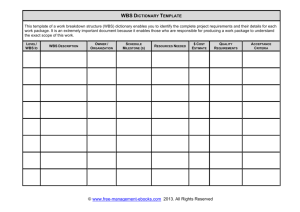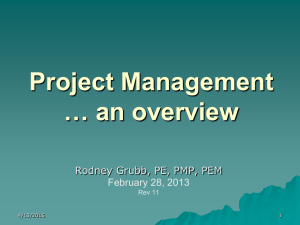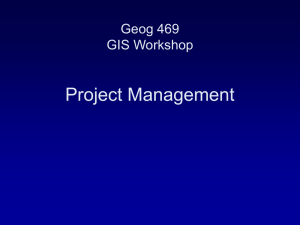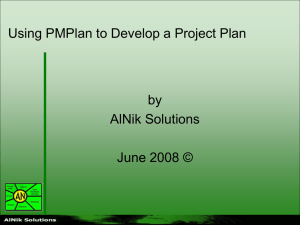review_questions
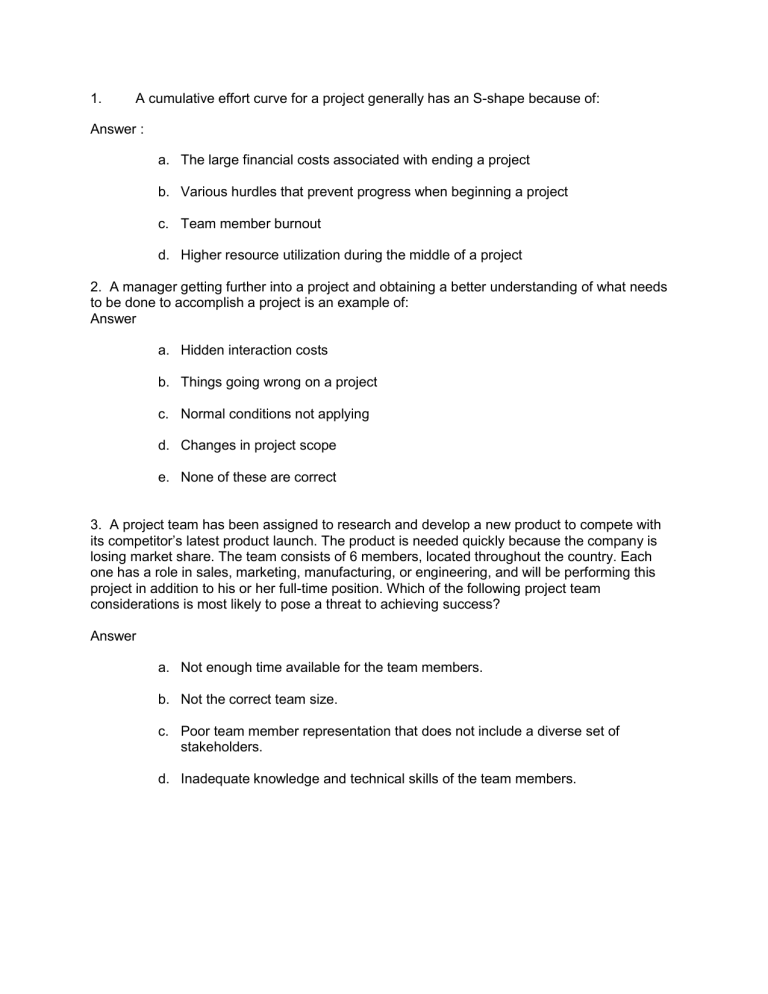
1. A cumulative effort curve for a project generally has an S-shape because of:
Answer : a. The large financial costs associated with ending a project b. Various hurdles that prevent progress when beginning a project c. Team member burnout d. Higher resource utilization during the middle of a project
2. A manager getting further into a project and obtaining a better understanding of what needs to be done to accomplish a project is an example of:
Answer a. Hidden interaction costs b. Things going wrong on a project c. Normal conditions not applying d. Changes in project scope e. None of these are correct
3. A project team has been assigned to research and develop a new product to compete with its competitor’s latest product launch. The product is needed quickly because the company is losing market share. The team consists of 6 members, located throughout the country. Each one has a role in sales, marketing, manufacturing, or engineering, and will be performing this project in addition to his or her full-time position. Which of the following project team considerations is most likely to pose a threat to achieving success?
Answer a. Not enough time available for the team members. b. Not the correct team size. c. Poor team member representation that does not include a diverse set of stakeholders. d. Inadequate knowledge and technical skills of the team members.
4. All of the following are usually included in a work package except
Answer a. What will be done? b. The time needed to complete the work. c. A single person who is responsible for its completion. d. All the costs for the work package. e. All of these are included in a work package.
5. An advantage of factor rating for project selection is that it:
Answer a. Involves no arithmetic calculations b. Allows for comparisons on several weighted criteria c. Offers objective measures that eliminate human bias d. Is focused solely on financial outcomes
6. An organization that allows functions to exist on the vertical dimension of the organizational chart, with projects running on the horizontal dimension is described as a:
Answer a. Matrix organization b. Projectized organization structure c. Functional organization d. Networked organization
7. After a team of software development engineers completed the requirements phase for a major new system, members learned the client no longer needed several of the features initially requested. Which of the following project management models would help avoid this kind of communication challenge?
Answer a. Silo approach b. Economic approach c. Waterfall approach d. Concurrent approach
8. Companies like Boeing, Kodak, and IBM are using which of the following for improving the estimating process?
Answer a. Adjusting estimates based on individual forecasting abilities b. Benchmarking using the experience of other companies c. Using time and motion studies d. Creating historical databases of previous projects e. All of these are correct
9.
10.
11. Assuming all activities are scheduled to begin on that early start times. How much can we delay activity D without delaying the project.
A. 3
B. 4
C. 5
D. 6
12. Design flaws being revealed after the fact, extreme weather conditions, and accidents occurring are examples of:
Answer a. Hidden interaction costs b. Things going wrong on a project c. Normal conditions not applying d. Changes in project scope
13. Fast tracking is defined as:
Answer e. None of these are correct a. rescheduling sequential tasks to take place simultaneously b. eliminating tasks or deliverables from the WBS c. increasing the efficiency of the employees performing the task d. adding resources to reduce the time required for selected project activities
14. Given the schedule below, what sequence of activities comprises the critical chain?
15. If a project criterion indicates that the project must meet a specific date, that criterion is classified as
Answer a. Constrained b. Enhanced c. Accepted d. Limited e. Fixed
16. Imagine your boss has assigned you to work on a project that is of strategic importance.
She tells you there will be no other team members available to help you. What arguments might you effectively raise in persuading her to allow you to work with a team?
Answer a. There will be less need for coordination b. There will be more breadth of technical expertise c. There will be less chance of conflict
17. In evaluating time-cost tradeoffs, we start by crashing the activity on the critical path that:
Answer d. There will be less need to gain buy-in a. can be reduced the most. b. has the lowest total crash cost. c. has the lowest crash cost per unit time. d. is the longest.
18. In today's business environment, project managers find it valuable to have a keen understanding of
Answer
A. Strategic management
B. Technical issues
C. Project selection process
D. Both A and C are correct
E. A, B, and C are all correct
19. NPV is a measure of:
Answer a. How long it will take to recuperate the cost of a project with future revenue or cost savings b. The difference between the estimated costs of a project and the present value associated with future cash flows c. The expected rate of return required in order for a company to pursue a project d. The return on initial investment of the project
20. Project Thunderbolt will incur $30,000 in cost during year 0 and will produce $10,000 in net cost savings to the company in years 1 through 6. What would the net present value be for this project for a 20% required rate of return?
Answer a. ($4,080) b. $3,250 c. $6,040 d. $7,850
21. Project X requires an initial investment of $1.5 million and will result in a payment of $2 million from the client at the end of three years. If the required rate of return is 8%, what is the
NPV for this project?
Answer a. $ 88,000 b. $ 500,000 c. $ 1,588,000 d. $ 3,654,000
22. Research has shown that multitasking has been linked with:
Answer a. Enhanced efficiency b. Expanded brain function. c. Reduced stress. d. None of the above.
23. Select all that apply : A new project manager is taking over his company’s annual charity event. Several members of the team have worked on this event project in previous years. In generating a time estimation for the various tasks, which of the following is (are) most likely to aid improve estimation accuracy?
Answer a. Set tight time goals so the team members are pushed to stay on schedule b. Add 25% to each person’s estimate c. Consult the previous project manager for historical information on task and project durations d. Involve the team members who will do the work
24 . Select all that apply : Important characteristics of preparation before a meeting include:
Answer a. A detailed agenda including subject, facilitator, time, and deliverables, sent in advance b. Arranging for refreshments if the meeting will last longer than 90 minutes c. Flexibility regarding the purpose because important issues may arise at the last minute that some team members want to discuss d. Ensuring that you have enough material to deliver a presentation for the full duration of the meeting
25. Select all that apply : Members of a project team have developed a schedule for an upcoming IT project. They observe that two activities, A. Hardware Design and B. Software
Design, must be complete before a third activity, C. Testing, can begin. Hardware and Software
Design share the same predecessor task, and each one is estimated to have a duration of 4 weeks. Based on historical data, team members estimate that activity A and activity B each has an 80% chance of finishing within the estimated time frame. Which of the following is true?
Answer a. Conjunctive event bias might cause the team to overestimate the likelihood that
A and B will be completed within 4 weeks. (i.e., they will think it is more likely than it really is.) b. The likelihood of A and B both finishing within 4 weeks would be 90% c. The likelihood of A and B both finishing within 4 weeks would be 64% d. Conjunctive event bias might cause the team to underestimate the likelihood that
A and B will be completed within 4 weeks. (i.e., they will think it is less likely than it really is.)
26. Select all that apply : To effectively motivate a team, the project manager should understand the following about motivation (select all correct items):
Answer a. Providing team members with clear, specific, challenging goals is among the most powerful motivators. b. Determining how to best motivate an individual may involve asking “What can I do to ensure you get the most out of this project.” c. Money is normally the most important motivator for project team members. d. People will be motivated if they feel a sense of ownership for the project.
27. Select all that apply : Which of the following are advantages to including the team in creating the WBS:
Answer a. Participati on in the creation of the WBS builds team members’ commitment to the project. b. Team members will gain a total view of the project through their involvement in creating the WBS. c. Participation in the creation of the WBS can bring conflicting views to the surface before it is too late to address them d. They are the content experts and best equipped to know what is involved in generating each deliverable
28. Select all that apply : Which of the following are characteristics of mind mapping when used as a tool for WBS development?
Answer a. Mind mapping engages the team. b.
Mind mapping stimulates creative thinking about the project’s activities c. The nonlinear nature of the mind mapping process brings out fewer ideas than outlining. d. Mind mapping helps generate enthusiasm and commitment to the project
29. Select all that apply : Which of the following categories are considered to be a typical sources of project uncertainty?
Answer a. Schedule b. Unknown unknowns c. Technical d. Business environment e. Contingencies
30. Select all that apply: Which of the following is (are) likely examples of symptoms/consequences of poorly launched projects?
Answer a. Members of a team fail to understand the performance standards on which the project will be measured. b. The project’s costs quickly escalate beyond the initial estimates. c. Needs of specific stakeholders are not understood.
31. The backward pass in project network calculations determines the
Answer a. Latest time's activities can begin b. Earliest time's activities can be finished c. Critical path d. Both A and C are correct e. A, B, and C are all correct
32. The first step of project scope definition is to
Answer a. Analyze the strategic plan b. Analyze the current budget plan c. Meet with team members d. Select team members e. Define the overall objective to meet the customer's needs
33. The final step in the creation of a Work Breakdown Structure is to
Answer a. Code the WBS for tracking b. Assign the cost account to a manager c. Assign the work package to a manager d. Develop the responsibility matrix e. All of these are included in the final step
34. The intended outcome of strategy/projects integration is
Answer a. Clear organization focus b. Best use of scare organization resources c. Improved communication across projects and departments d. Both A and C are correct e. A, B, and C are all correct
35. The minimum amount of time a dependent activity must be delayed to begin or end is referred to as:
Answer a. Hammock b. Laddering c. Lag d. Cushion e. Buffer
36. The laying pipe example in the text illustrates the concept of
Answer a. Laddering b. Hammock activities c. Critical path d. Concurrent engineering e. Forward pass
37. What is the critical chain in the schedule below?
Answer a. A-B-D-F-G b. A-C-E-G c. A-B-D-E-G d. A-B-D-E-F-G
38. When is crashing beneficial to a project?
Answer a. When the task to be crashed is not on the critical path b. When there are no delay penalties c. When the cost of crashing by one day is less than the project’s daily overhead cost d. When the cost of crashing by one day is more than the project’s daily overhead cost.
39. Which company utilized concurrent engineering to design a new line of cars and in the process completed its development six months ahead of schedule?
Answer a. General Motors b. Chrysler c. Ford d. Nissan e. Toyota
40. Which of the following factors can influence the selection of a project as it moves through the project selection funnel?
Answer a. Organizational politics b. Resource constraints c. Strategic goals d. All of the above
41. Which of the following financial models are typically included in project selection?
Answer a. Payback b. Net present value c. Internal rate of return d. Both A and B are correct e. A, B, and C are all correct
42. Which of the following is an example of a start-to start relationship? a. We cannot start design until five weeks after requirements definition is complete b. Editing cannot begin until two weeks after we have started writing the book c. We cannot start pouring the concrete until the foundation has been completely excavated. d. The paving job cannot finish until we have started to put up the signs
43. Which of the following is typically NOT included in a project charter?
Answer a. A list of project stakeholders. b. The name of the project sponsor c. A communication plan d. Preliminary project deliverables
44. Which of the following is NOT a characteristic of the PERT method?
Answer a. It assumes project activities are independent of each other and not affected by common factors. b. Total project time (T(E)) is assumed to have a normal distribution. c. The distribution of possible times for an individual activity is described as a beta distribution. d. Activity estimates are known and certain. e. All of the above are characteristics of the PERT method.
45. Which of these are characteristics of the best project managers?
Answer a. Disciplined, yet flexible b. Creative, but not too technical c. Sensitive, yet tyrannical d. Extrovert
46. Which of the following top-down methods is used when projects closely follow past projects in features and costs and result in costs being assigned by percentages to major segments of the project? a. Apportion b. Function point c. Phase estimating d. Learning curve e. Censensus
47. Which of these is the critical path for this project schedule?
A-B-F-G
A-B-D-G
A-C-E-G
A-G
48. Which WBS approach is most likely to leave team members with individual views of the work packages, but not an entire view of the project?
Answer a. Mind mapping b. Bottom-Up Approach c. Top Down approach


